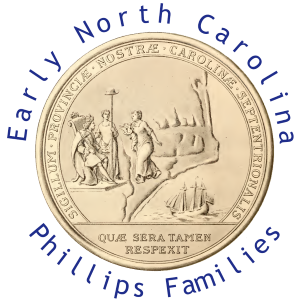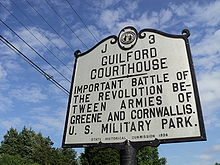Guilford County, North Carolina
From ENC Phillips Group Wiki
| Guilford County | |

| |
| Founded 1771 | |
| Website www.co.guilford.nc.us | |
Guilford County is a county located in the U.S. state of North Carolina. In 2007, the Census Bureau estimated the county's population to be 465,931. Its seat is GreensboroTemplate:GR. Since 1938, an additional county court has been located in High Point, North Carolina, making Guilford one of only a handful of counties nationwide with a dual court system. The county is part of the Piedmont Triad metropolitan area.
Contents
History
Beginning in the 1740s, European settlers arrived in the region in search of fertile and affordable land. These first settlers included German Reforned and Lutherans in the east, British Quakers in the south and west, and Scotch-Irish Presbyterians in the center of today's Guilford County.[1] The county was formed in 1771 from parts of Rowan County and Orange County. It was named for Francis North, 1st Earl of Guilford, father of Frederick North, Lord North, British Prime Minister from 1770 to 1782.
Friedens Church, whose name means "peace" in German, is in eastern Guilford County, at 6001 North Carolina Route 12, northwest of Gibsonville. It is a historic church that has operated continuously since the earliest European settlers came to this area. According to a history of the church, Rev. John Ulrich Giesendanner led his Lutheran congregation from Pennsylvania in 1740, into the part of North Carolina around Haw River, Reedy Fork, Eno River, Alamance Creek, Travis Creek, Beaver Creek and Deep River. The first building used by Friedens church was made of logs in 1745 and served for 25 years. The second building, completed about 1771, was much more substantial and remained in use until it was replaced in May, 1871. The third building was destroyed by fire on January 8, 1939. Only the columns in front survived. The structure was rebuilt and reopened in May 1939.[2]
The Quaker church played a major role in the European settlement of the county, and numerous Quakers still live in the county. New Garden Friends Meeting, established in 1754, still operates in Greensboro.
Alamance Presbyterian Church, a log structure, was built in 1762, though it was not officially organized until 1764 by the Rev. Henry Patillo, pastor of Hawfields Presbyterian Church. It has operated on the same site in present-day Greensboro since then. According to the church history, it is now using its fifth church building and now has its eighteenth pastor.[3]
On March 15, 1781, the Battle of Guilford Court House was fought just north of present-day Greensboro between Generals Charles Cornwallis and Nathanael Greene during the American Revolution. This battle marked a key turning point in the Revolutionary War in the South. Although General Cornwallis, the British Commander, held the field at the end of the battle, his losses were so severe that he decided to withdraw to the Carolina and Virginia coastline, where he could receive reinforcements and his battered army could be protected by the British Navy. His decision ultimately led to his defeat later in 1781 at Yorktown, Virginia, by a combined force of American and French troops and warships.
In 1779 the southern third of Guilford County became Randolph County. In 1785 the northern half of its remaining territory became Rockingham County.
In 1808, Greensboro replaced the hamlet of Guilford Court House as the county seat.
The county was site of early industrial development. The establishment of the Mt. Hecla Cotton Mill in 1818 marks one of the earliest cotton mills in the state. The re-establishment of the mill as a steam-powered factory is among the earliest examples of the use of steam power in the state.[4]
Many of the county's residents were opposed to slavery before the Civil War. The county was a stop on the famous Underground Railroad, which provided escaped slaves with a route to freedom in the North. Levi Coffin, one of the founders of the "railroad", was a Guilford County native. He is credited with personally helping over 2,000 slaves escape to freedom before the war.
Education has long been a hallmark of the county. Guilford College was founded in 1837 as the New Garden Boarding School, its name changed in 1888 when the academic program expanded considerably. Guilford is the third-oldest coeducational institution in the country and the oldest such institution in the South. Greensboro College, established by the Methodist Church through a charter secured in 1838, is one of the oldest institutions of higher education for women in the United States.
In 1891, the county became home to the state's first and only publicly supported institution of higher learning for women, the State Normal and Industrial School. In 1932, the school became the Women's College of North Carolina when it joined with the University of North Carolina at Chapel Hill and NC State University in Raleigh to form the Consolidated University of North Carolina. From the 1930s to the 1960s the Women's College was the third-largest women's university in the world. The school's name was changed a final time in 1963 when it began admitting men; it is now known as the University of North Carolina at Greensboro.
In 1960 Guilford County helped spark a major development in the American civil rights movement when four black students from the North Carolina A&T State University in Greensboro started an early civil rights sit-in. Known afterwards as the Greensboro Four, the four men deliberately sat at a "whites-only" lunch counter at the Woolworth's store in downtown Greensboro and asked to be served. They were arrested, but their action led to many other college students in Greensboro - including white students from Guilford College and the Women's College - to sit at the lunch counter in a show of support. Within two months the sit-in movement spread to 54 cities in 9 states; Woolworth's eventually agreed to desegregate its lunch counters and other restaurants in Southern towns and cities followed suit.
A darker racial incident in 1979 was called the Greensboro massacre. In this incident the predominantly African American Communist Workers Party (CWP) led a march protesting the Ku Klux Klan and other white-supremacist groups through a black neighborhood in southeastern Greensboro. They were attacked and shot at by the Ku Klux Klan and members of the American Nazi Party, several of the Communist Party marchers were killed or wounded in the attack. The case received further national publicity when the accused shooters were found "not guilty" by an all-white jury.
Prominent Guilford County residents
- Joseph Gurney Cannon; powerful United States Congressman who served as the 40th Speaker of the United States House of Representatives from 1903 to 1911.
- Arthur Forbis, captain of the Guilford County militia at the Battle of Guilford Courthouse, where he was mortally wounded, March 15, 1781.
- Dolley Madison, wife of President James Madison and the fourth First Lady of the United States.
- William Sydney Porter, short-story writer better-known as "O. Henry"; his most famous story is "The Ransom of Red Chief".
- Edward R. Murrow, legendary radio and television journalist for CBS News from the 1930s to the 1960s. During the Second World War his broadcasts from London during the Battle of Britain played a major role in raising sympathy for the allies. In the 1950s he played a major role in the downfall of Wisconsin Senator Joseph R. McCarthy, thus ending his "witch-hunt" for Communist spies within the U.S. government. He is often considered one of the founding fathers of television journalism.
- Levi Coffin, abolitionist leader who was nicknamed the "President of the Underground Railroad" for helping escaped slaves to freedom in the North before the Civil War.
Law and government
Guilford County is a member of the regional Piedmont Triad Council of Governments.
Geography
According to the U.S. Census Bureau, the county has a total area of 658 square miles (1,703 km²), of which, 649 square miles (1,682 km²) of it is land and 8 square miles (21 km²) of it (1.26%) is water.
The county is drained, in part, by the Deep and Haw Rivers.
Townships
The county is divided into eighteen townships: Bruce, Center Grove, Clay, Deep River, Fentress, Friendship, Gilmer, Greene, High Point, Jamestown, Jefferson, Madison, Monroe, Morehead, Oak Ridge, Rock Creek, Sumner, and Washington.
Adjacent counties
- Rockingham County (north)
- Alamance County (east)
- Randolph County (south)
- Davidson County (southwest)
- Forsyth County (west)

|
Rockingham County | 
| ||
| Forsyth County | Alamance County | |||
| Davidson County | Randolph County |
National protected area
Demographics
As of the censusTemplate:GR of 2000, there were 421,048 people, 168,667 households, and 109,802 families residing in the county. The population density was 648 people per square mile (250/km²). There were 180,391 housing units at an average density of 278 per square mile (107/km²). The racial makeup of the county was 64.53% White, 29.27% Black or African American, 0.46% Native American, 2.44% Asian, 0.03% Pacific Islander, 1.81% from other races, and 1.45% from two or more races. 3.80% of the population were Hispanic or Latino of any race.
There were 168,667 households out of which 30.40% had children under the age of 18 living with them, 48.00% were married couples living together, 13.40% had a female householder with no husband present, and 34.90% were non-families. 27.90% of all households were made up of individuals and 8.30% had someone living alone who was 65 years of age or older. The average household size was 2.41 and the average family size was 2.96.
In the county the population was spread out with 23.70% under the age of 18, 11.00% from 18 to 24, 31.40% from 25 to 44, 22.10% from 45 to 64, and 11.80% who were 65 years of age or older. The median age was 35 years. For every 100 females there were 92.00 males. For every 100 females age 18 and over, there were 88.60 males.
The median income for a household in the county was $42,618, and the median income for a family was $52,638. Males had a median income of $35,940 versus $27,092 for females. The per capita income for the county was $23,340. About 7.60% of families and 10.60% of the population were below the poverty line, including 13.80% of those under age 18 and 9.90% of those age 65 or over.
Guilford County also has the highest rate of arrest for possession of marijuana in the entire state of North Carolina.
Cities and towns
- Greensboro
- High Point
- Jamestown
- Oak Ridge
- Pleasant Garden
- Sedalia
- Stokesdale
- Summerfield
- Whitsett
- Colfax
- Browns Summit
- Gibsonville
Part of Archdale and Kernersville are in Guilford County
Census-designated places
See also
References
- ↑ Bishir, Catherine (2005). North Carolina Architecture. UNC Press. pp. 322. http://books.google.com/books?id=NccTgQkmPIEC&client=opera.
- ↑ Apple, Lalah G. Two Hundred Twenty-Five Years History of Friedens Lutheran Church 1745 - 1970.
- ↑ "History of Alamance Presbyterian Church." Accessed May 25, 2010
- ↑ Arnett, Ethel Stephens. Greensboro, North Carolina; the County Seat of Guilford. Chapel Hill: UNC Press, 1955. p. 166
External links
| This page uses content from the English language Wikipedia adapted for use as a quick research reference on this wiki. The original content was here: Guilford County, North Carolina. The list of authors can be seen in the page history. As with the ENC Phillips Group Wiki, the content of Wikipedia is available under the Creative Commons License. |


